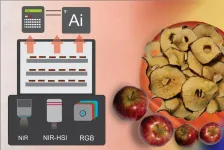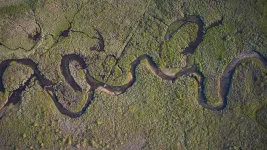(Press-News.org) New Haven, Conn. — If you like the smell of spring roses, the sounds of summer birdsong, and the colors of fall foliage, you have the stabilization of the ozone layer to thank for it. Located in the stratosphere, where it shields the Earth from harmful ultraviolet radiation, the ozone layer plays a key role in preserving the planet’s biodiversity.
And now we may have a better idea of why that took so long — more than 2 billion years — to happen.
According to a new, Yale-led study, Earth’s early atmosphere hosted a battle royale between iodine and oxygen — effectively delaying the creation of a stable ozone layer that would shield complex life from much of the sun’s ultraviolet radiation (UVR).
The new theory, described in a study in the journal Proceedings of the National Academies of Science, may solve a mystery that has puzzled scientists for hundreds of years.
“The origin and diversification of complex life on Earth remains one of the most profound and enduring questions in natural science,” said Jingjun Liu, a doctoral student in Earth and planetary sciences at Yale and first and corresponding author of the new study.
Indeed, scientists have long wondered why land plants did not emerge on Earth until 450 million years ago, even though their progenitors, cyanobacteria, had been in existence for 2.7 billion years. Likewise, there are no fossils for complex land animals or plants before the Cambrian era (541 to 485 million years ago) despite the evidence of much older microfossils.
“The only existing explanation states that this delay is an intrinsic characteristic of evolution — that an enormous amount of time is required,” said Noah Planavsky, a professor of Earth and planetary sciences, faculty member of the Yale Center for Natural Carbon Capture, and senior author of the new study. “Yet that notion fails to explain how and why complex life originated and diversified.”
The new study suggests that something beyond the need for time was responsible: the delayed stabilization of Earth’s ozone layer, caused by elevated marine iodine concentrations that prevented a protective UVR shield from forming in the atmosphere.
Ozone production depends on atmospheric oxygen and background UVR. It has been widely accepted by scientists that once Earth established a substantial concentration of atmospheric oxygen, the planet formed an ozone layer that allowed for biological evolution to proceed unimpeded.
“We challenge this paradigm by considering how Earth’s evolving iodine cycle may have influenced ozone abundance and stability,” Liu said.
For the study, a Yale-led research team analyzed multiple lines of independent geological evidence and developed an ocean-atmosphere model to reconstruct the iodine-ozone dynamics for the early Earth. The researchers found that elevated marine iodide content (formed when iodine combines with another element to form a salt) prevailed through most of Earth’s history, which would have led to significant inorganic iodine emissions into the atmosphere after the rise of oxygen — with the potential for disrupting ozone.
The mechanism of ozone destruction by iodine is similar to the process by which chlorofluorocarbons (CFCs) created the “ozone hole” over Antarctica. When CFCs undergo photolysis, they release reactive chlorine, which catalytically destroys ozone in the stratosphere, leading to as much as a 50% depletion over continental Antarctica at the peak of the problem.
“Iodine-driven catalytic cycles for ozone destruction follow a similar process and are kinetically much faster than those involving reactive chlorine,” Planavsky said. “Our photochemical calculations indicate that even a moderate increase in marine inorganic iodine emission could result in a whole atmosphere ozone depletion by tens or even hundreds of times relative to modern levels.”
Liu noted that at a global scale, unstable and low ozone levels likely persisted from 2.4 billion years ago until roughly half a billion years ago. “During this interval, even under high levels of oxygen production, atmospheric ozone could have been very low and was likely unstable, leading to periodic or persistent high fluxes of solar UVR at Earth’s surface,” Liu said.
Dalton Hardisty of Michigan State University, James Kasting of Pennsylvania State University, and Mojtaba Fakhraee of Yale are co-authors of the study.
# # #
END
FOR IMMEDIATE RELEASE
Tuesday, January 7, 2025
Contact:
Jillian McKoy, jpmckoy@bu.edu
Michael Saunders, msaunder@bu.edu
##
More than half of US college students experienced alcohol-related harms caused by others, according to the first national probability-based survey of such harms conducted in 20 years. The findings, published in the journal Drug and Alcohol Review in December, shed light on how others’ drinking affects students’ health, academics, and safety.
“Our research ...
URBANA, Ill.– Food drying is a common process for preserving many types of food, including fruits and meat; however, drying can alter the food’s quality and nutritional value. In recent years, researchers have developed precision techniques that use optical sensors and AI to facilitate more efficient drying. A new study from the University of Illinois Urbana-Champaign discusses three emerging smart drying techniques, providing practical information for the food industry.
“With traditional drying systems, you need to remove samples to monitor the process. But with smart drying, or precision drying, you can continuously ...
The typical cost of developing new medications may not be as high as generally believed, with a few ultra-costly medications skewing public discussions about the cost of pharmaceutical research and development, according to a new RAND study.
Using a novel method to assess spending on research and development for 38 drugs that were recently approved by the U.S. Food and Drug Administration, researchers found that the mean, or average, cost of developing a new drug was much higher than the mid-point (median) cost of development.
Researchers estimated a median direct research and development cost of $150 million compared to a mean of $369 million.
Costs ...
HERSHEY, Pa. — Autoimmune diseases, where the immune system mistakenly attacks the body’s own healthy cells and tissues, often have a preclinical stage before diagnosis that’s characterized by mild symptoms or certain antibodies in the blood. However, in some people, these symptoms may resolve before culminating in the full disease stage.
Knowing who may progress along the disease pathway is critical for early diagnosis and intervention, improved treatment and better disease management, according to a team led by researchers from the ...
Love doesn’t come with an instruction manual, but for autistic adults seeking to navigate the complexities of romance, a UCLA Health program offers a roadmap to finding and sustaining meaningful relationships through the launch of a new research study, called PEERS for Dating.
Led by the UCLA Program for the Education and Enrichment of Relationship Skills (PEERS) Clinic, the new 20-week program aims to demystify the often complex social rules surrounding dating and help participants gain a deeper understanding of relationship dynamics
“Romantic relationships can be transformative, but for many autistic adults, the path to connection can feel uncertain,” ...
How would you summarize your study for a lay audience?
Our research focuses on sleep spindles—short bursts of brain activity during sleep that are crucial for stabilizing sleep and supporting memory.
Sleep spindles are of great interest because changes in spindle activity have been linked to many neurodevelopmental and neurodegenerative disorders, such as Alzheimer’s disease and autism.
While many factors influence when and how these spindles occur, such as sleep stages or brain rhythms, we discovered that short-term patterns, like a musical rhythm spanning just a few seconds, play the most ...
Researchers from Princeton University and the University of Arizona have created a simulation that maps underground water on a continental scale. The result of three years’ work studying groundwater from coast to coast, the findings plot the unseen path that each raindrop or melted snowflake takes before reemerging in freshwater streams, following water from land surface to depths far below and back up again, emerging up to 100 miles away, after spending from 10 to 100,000 years underground.
The simulation, published Jan. 6 in the journal Nature Water, shows that rainfall and snowmelt ...
WASHINGTON, D.C. - A diverse group of 164 undergraduate students and six faculty will participate in unique workforce development programs at 11 of the nation’s national laboratories and a fusion facility during Spring 2025.
This opportunity is part of a continuing effort by the Department of Energy (DOE) to ensure the nation has a strong, sustained workforce trained in the skills needed to address the energy, environment, and national security challenges of today and tomorrow.
“The ...
January 7, 2025, Mountain View, CA -- The SETI Institute announces the 2024 SETI Forward Award recipients: Gabriella Rizzo and Pritvik Sinhadc. This year's recipients worked on research projects to understand extremophiles in deep-sea hydrothermal vents and to analyze gravitational wave signals for potential extraterrestrial technosignatures. Established by Lew Levy, SETI Forward committee founder and member of the SETI Institute’s Council of Advisors, this award is a beacon for promising young scientists. The goal is to connect students with opportunities that foster their ...
The Brain & Behavior Research Foundation (BBRF) has announced the 2024 Leading Research Achievements by BBRF grantees, prizewinners, and scientific council members. It includes important studies of suicide, childhood anxiety, depression, eating disorders, cocaine addiction, and other aspects of brain and behavior illness.
The 2024 Leading Research Achievements are:
Suicide Risk Fluctuates Across the Menstrual Cycle, Affecting Different Women Differently
Tory Anne Eisenlohr-Moul, Ph.D., University of Illinois, Chicago
Preliminary Trial of Psychoactive ...





